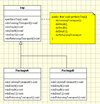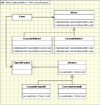Design Patterns
By definition, Design Patterns are reusable solutions to commonly occuring problems(in the context of software design). Design patterns were started as best practices that were applied again and again to similar problems encountered in different contexts. They become popular after they were collected, in a formalized form, in the Gang Of Four book in 1994. Originally published with c++ and smaltalk code samples, design patterns are very popular in Java and C# can be applied in all object oriented languanges. In functional languages like Scala, certain patterns are not necesary anymore.
Creational Design Patterns:
Click to zoom


Singleton - Ensure that only one instance of a class is created and Provide a global access point to the object.
When to Use
,
Common Usage
,
Examples: Lazy Singleton in Java,
, Early Singleton in Java
Singleton pattern should be used when we must ensure that only one instance of a class is created and when the instance must be available through all the code. A special care should be taken in multi-threading environments when multiple threads must access the same resources through the same singleton object.
There are many common situations when singleton pattern is used:
- Logger Classes
- Configuration Classes
- Accesing resources in shared mode
- Other design patterns implemented as Singletons: Factories and Abstract Factories, Builder, Prototype
- Logger Classes
- Configuration Classes
- Accesing resources in shared mode
- Other design patterns implemented as Singletons: Factories and Abstract Factories, Builder, Prototype
Click to zoom


Factory(Simplified version of Factory Method) - Creates objects without exposing the instantiation logic to the client and Refers to the newly created object through a common interface.
When to Use
,
Common Usage
Factory pattern should be used when:
- a framework delegate the creation of objects derived from a common superclass to the factory
- we need flexibility in adding new types of objects that must be created by the class
Along with singleton pattern the factory is one of the most used patterns. Almost any application has some factories. Here are a some examples in java:
- factories providing an xml parser: javax.xml.parsers.DocumentBuilderFactory or javax.xml.parsers.SAXParserFactory
- java.net.URLConnection - allows users to decide which protocol to use
- factories providing an xml parser: javax.xml.parsers.DocumentBuilderFactory or javax.xml.parsers.SAXParserFactory
- java.net.URLConnection - allows users to decide which protocol to use
Click to zoom
 Document Application Example
Document Application Example

 Document Application Example
Document Application Example
Factory Method - Defines an interface for creating objects, but let subclasses to decide which class to instantiate and Refers to the newly created object through a common interface.
When to Use
,
Common Usage
Factory Method pattern should be used when:
- a framework delegate the creation of objects derived from a common superclass to the factory
- the base factory class does not know what concrete classes will be required to create - delegates to its subclasses the creation of concrete objects
- factory subclasses subclasses are aware of the concrete classes that must be instantiated
Factory method pattern, compared to Factory pattern replace the factory with an abstract class and a set of concrete factories subclasses. The subclasses are responsible for creating concrete product objects; for factory method is possible adding new product classes without changing the abstract factory. The same result can be achieved for simplified factory pattern if reflection is used.
- a framework delegate the creation of objects derived from a common superclass to the factory
- the base factory class does not know what concrete classes will be required to create - delegates to its subclasses the creation of concrete objects
- factory subclasses subclasses are aware of the concrete classes that must be instantiated
Factory method pattern, compared to Factory pattern replace the factory with an abstract class and a set of concrete factories subclasses. The subclasses are responsible for creating concrete product objects; for factory method is possible adding new product classes without changing the abstract factory. The same result can be achieved for simplified factory pattern if reflection is used.
Along with singleton pattern the factories are the most used patterns. Almost any application has some factories. Here are a some examples:
- factories providing an xml parser: javax.xml.parsers.DocumentBuilderFactory or javax.xml.parsers.SAXParserFactory
- factories providing an xml parser: javax.xml.parsers.DocumentBuilderFactory or javax.xml.parsers.SAXParserFactory
Click to zoom
 Look & Feel Example
Look & Feel Example

 Look & Feel Example
Look & Feel Example
Abstract Factory - Offers the interface for creating a family of related objects, without explicitly specifying their classes.
When to Use
,
Common Usage
,
Example: Gui Look & Feel in Java
Abstract Factory should be used when:
- A system should be configured with one of multiple families of products
- A system should be independent of how its products are created, composed and represented
- Products from the same family should be used all together, products from different families ahould not be used togheter and this constraint must be ensured.
- Only the product interfaces are revealed, the implementations remains hidden to the clients.
Examples of abstract factories:
- java.awt.Toolkit - the abstract superclass of all actual implementations of the Abstract Window Toolkit. Subclasses of Toolkit are used to bind the various components to particular native toolkit implementations(Java AWT).
- javax.swing.LookAndFeel - an abstract swing factory to swithct between several look and feel for the components displayed(Java Swing).
- java.sql.Connection - an abstract factory which create Statements, PreparedStatements, CallableStatements,... for each database flavor.
Click to zoom
 Text Converter Example
Text Converter Example

 Text Converter Example
Text Converter Example
Builder - Defines an instance for creating an object but letting subclasses decide which class to instantiate and Allows a finer control over the construction process.
Example: Text Converter in Java
Click to zoom


Prototype - Specify the kinds of objects to create using a prototypical instance, and create new objects by copying this prototype.
Click to zoom
 Database Example
Database Example

 Database Example
Database Example
Object Pool - reuses and shares objects that are expensive to create..
When to Use
,
Common Usage
,
Sourcecode: Database Connection Pool in Java
Basically, we'll use an object pool whenever there are several clients who needs the same stateless resource which is expensive to create.
The most common situations when object pool pattern is used:
- Database Connections
- Remote Objects
- Database Connections
- Remote Objects
Behavioral Design Patterns:
Click to zoom


Chain of Responsibiliy - It avoids attaching the sender of a request to its receiver, giving this way other objects the possibility of handling the request too.
- The objects become parts of a chain and the request is sent from one object to another across the chain until one of the objects will handle it.
Sourcecode:
- The objects become parts of a chain and the request is sent from one object to another across the chain until one of the objects will handle it.
Click to zoom
 Restaurant Example
Restaurant Example

 Restaurant Example
Restaurant Example
Command - Encapsulate a request in an object, Allows the parameterization of clients with different requests and Allows saving the requests in a queue.
Sourcecode: Buying/Selling stocks in Java
Click to zoom


Interpreter - Given a language, define a representation for its grammar along with an interpreter that uses the representation to interpret sentences in the language / Map a domain to a language, the language to a grammar, and the grammar to a hierarchical object-oriented design
Sourcecode: Romans Numerals Converter in Java
Click to zoom


Iterator - Provide a way to access the elements of an aggregate object sequentially without exposing its underlying representation.
Sourcecode: Java Iterator
Click to zoom


Mediator - Define an object that encapsulates how a set of objects interact. Mediator promotes loose coupling by keeping objects from referring to each other explicitly, and it lets you vary their interaction independently.
Sourcecode:
Click to zoom
 News Publisher Example
News Publisher Example

 News Publisher Example
News Publisher Example
Observer - Define a one-to-many dependency between objects so that when one object changes state, all its dependents are notified and updated automatically.
Sourcecode: News Publisher in Java
Click to zoom
 Robot Example
Robot Example

 Robot Example
Robot Example
Strategy - Define a family of algorithms, encapsulate each one, and make them interchangeable. Strategy lets the algorithm vary independently from clients that use it.
Sourcecode: Robot Application in Java
Click to zoom
 Travel Example
Travel Example

 Travel Example
Travel Example
Template Method - Define the skeleton of an algorithm in an operation, deferring some steps to subclasses / Template Method lets subclasses redefine certain steps of an algorithm without letting them to change the algorithm's structure.
Sourcecode: Travel Agency Application in Java
Click to zoom
 Customers Example
Customers Example

 Customers Example
Customers Example
Visitor - Represents an operation to be performed on the elements of an object structure / Visitor lets you define a new operation without changing the classes of the elements on which it operates.
Sourcecode: Customers Report Example
Click to zoom


Null Object - Provide an object as a surrogate for the lack of an object of a given type. / The Null Object Pattern provides intelligent do nothing behavior, hiding the details from its collaborators.
Sourcecode:
Structural Design Patterns:
Click to zoom


Adapter - Convert the interface of a class into another interface clients expect. / Adapter lets classes work together, that could not otherwise because of incompatible interfaces.
Click to zoom
 Click to zoom
Click to zoom

 Click to zoom
Click to zoom
Bridge - Compose objects into tree structures to represent part-whole hierarchies. / Composite lets clients treat individual objects and compositions of objects uniformly.
Sourcecode: Object Persistence Api in Java
Click to zoom
 Shapes Example
Shapes Example

 Shapes Example
Shapes Example
Composite - Compose objects into tree structures to represent part-whole hierarchies. / Composite lets clients treat individual objects and compositions of objects uniformly.
Sourcecode: Shapes Example in Java
Click to zoom
 GUI Example
GUI Example

 GUI Example
GUI Example
Decorator - add additional responsibilities dynamically to an object.
Sourcecode: Gui Application Example
Click to zoom
 Wargame Example
Wargame Example

 Wargame Example
Wargame Example
Flyweight - use sharing to support a large number of objects that have part of their internal state in common where the other part of state can vary.
Sourcecode: Java Wargame Example
Click to zoom
 Calculator Example
Calculator Example

 Calculator Example
Calculator Example
Memento - capture the internal state of an object without violating encapsulation and thus providing a mean for restoring the object into initial state when needed.
Source Code: Calculator Example in Java
Click to zoom
 Image Viewer
Image Viewer

 Image Viewer
Image Viewer
Proxy - provide a “Placeholder” for an object to control references to it.
Sourcecode: Proxy Pattern in Java